Classification of Minerals(8. Silicates-1)
8. Silicates
Silicates comprise over 90% of the earth's crust. Most rock-forming minerals are silicates, which are about 40% of all known minerals. Therefore, many of the rocks we commonly see in nature, consist of silicate minerals. Furthermore, soils are composed mainly of silicates. We can also find silicates even in extraterrestrial materials like meteorites.
Tetrahedra form a basic structure of silicates, where the silicon atoms are in fourfold coordination with oxygen. The subclasses of silicates can be acquired from the combination of silicon-oxygen tetrahedra: nesosilicates (independent tetrahedra), sorosilicates (double tetrahedra), cyclosilicates (ring structure), inosilicates (chain structure), phyllosilicates (sheet structure) and tectosilicates (three dimensional network).
The silicate minerals are important to our daily lives. While sulfides supply us with many metals, silicates give us many source materials for industry (bricks, glasses and porcelains) as well as daily necessities (paper coating, fillers, catalysts and absorbents).

Datolite Japan
Datolite, together with zeolite and calcite, is commonly found in voids within basalt.
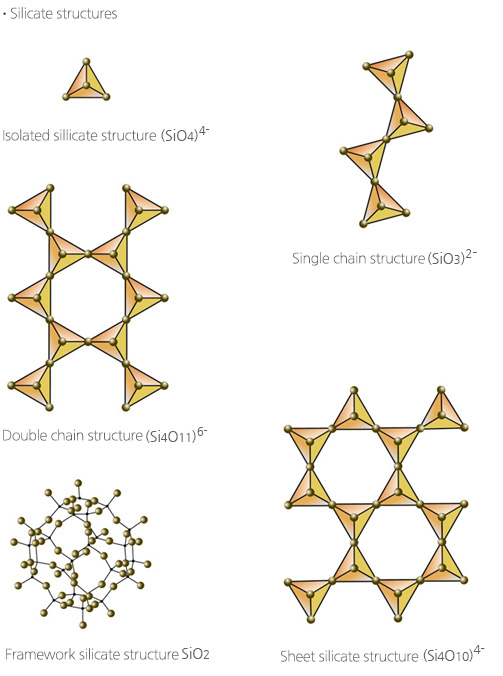
(1) Nesosilicates
Among the subsilicates, nesosilicates have the simplest structures. The SiO4 tetrahedra are independent and bound to each other by ionic bonds from interstitial cations, which are similar to sulfates and phosphates. Their strong ionic bonds and close packing of ions explain that their specific gravities, indices of refraction and hardness are relatively higher than other chemically similar silicates. They are generally characterized by equidimensional crystal habits and poor development of cleavages.
Nesosilicates include olivine, garnet, zircon, sillimanite, andalusite, kyanite, topaz, staurolite, datolite and titanite. Some nesosilicate minerals, including topaz, andalusite, garnet (pyrope, almandine, spessartine, uvarovite, grossular and andradite) and zircon are used as gems. The olivine series forms a complete solid solution with two end members, forsterite and fayalite. Garnets can be grouped into pyralspite (pyrope, almandine and spessartine) and ugrandite (uvarovite, grossular and andradite). Andalusite, sillimanite and kyanite are polymorphs of Al2SiO5.

AndraditeMexico
Andradite is the most commonly encountered minerals in the garnet group. It is used as a gemstone.
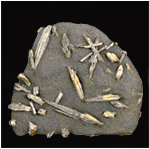
StauroliteGoseong, Korea
Staurolite was named after a Greek word meaning 'cross' and is sometimes called cross stone or fairy stone.
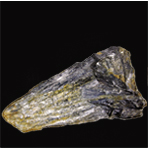
Kyanite Nonsan, Korea
Kyanite is characterized by blue color, bladed crystals and good cleavage. It is trimorphic with andalusite and sillimanite.
(2) Sorosilicates
Sorosilicates have two SiO4 tetrahedra linked by sharing one oxygen to form discrete Si2O76- groups. Among silicates, minerals belonging to this subclass are small in numbers, just over 70.
Sorosilicates include hemimorphite, lawsonite, epidote, clinozoisite, zoisite, allanite, vesuvianite, ilvaite and bertrandite. The epidote group members are zoisite, clinozoisite, epidote and allanite, which are isostructural and monoclinic except zoisite. Zoisite, a polymorph of clinozoisite, is orthorhombic. Tanzanite, a blue-colored variety of zoisite, is used as a gem mineral. Hemimorphite, once called calamine, was named after the hemimorphic nature of its crystals. Vesuvianite, sometimes called idocrase, was named after Mount Vesuvius. Ilvaite is similar to lawsonite although not identical in structure.
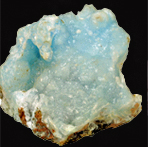
Hemimorphite Mexico
Hemimorphite is named after Greek word for "half shape" referring to the contrasting terminations at opposite ends of a crystal. It commonly forms needle- or fan-shaped aggregates of thin, colourless, bladed crystals; or as blue, blue-green botryoidal crusts. It is used as an ore mineral of zinc.
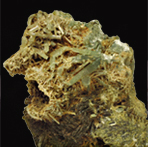
Epidote with Rock Crystal Miryang, Korea
Epidote, formed generally by metamorphism, is characterized by glassy luster, green color and columnar crystal form. Transparent and clear crystals of epidote are used as a gem.